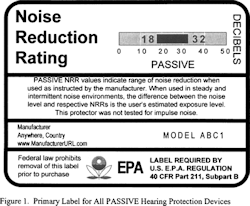Noise Reduction Ratings (NRR)
Hearing protectors must adequately reduce the noise level for each employee's work environment.
Most employers use the Noise Reduction Rating (NRR) that represents the protector's ability to reduce noise under ideal laboratory conditions. The employer then adjusts the NRR to reflect noise reduction in the actual working environment.
Standard Threshold Shift (STS)
OSHA's definition of a standard threshold shift is a change, relative to an earlier baseline hearing test, of 10 dB or more in the average hearing level at 2000, 3000, and 4000 Hz in either ear.
Age corrections (listed as an appendix in the OSHA standard) may be used when determining STS, although they are not required. Another federal agency, the Mine Safety and Health Administration (MSHA), has also adopted the OSHA STS criteria.
Knowledge Check Choose the best answer for the question.
6-8. OSHA's definition of a standard threshold shift is a change, relative to baseline, of _____ dB or more in the average hearing level at 2000, 3000, and 4000 Hz in either ear.
You forgot to answer the question!

